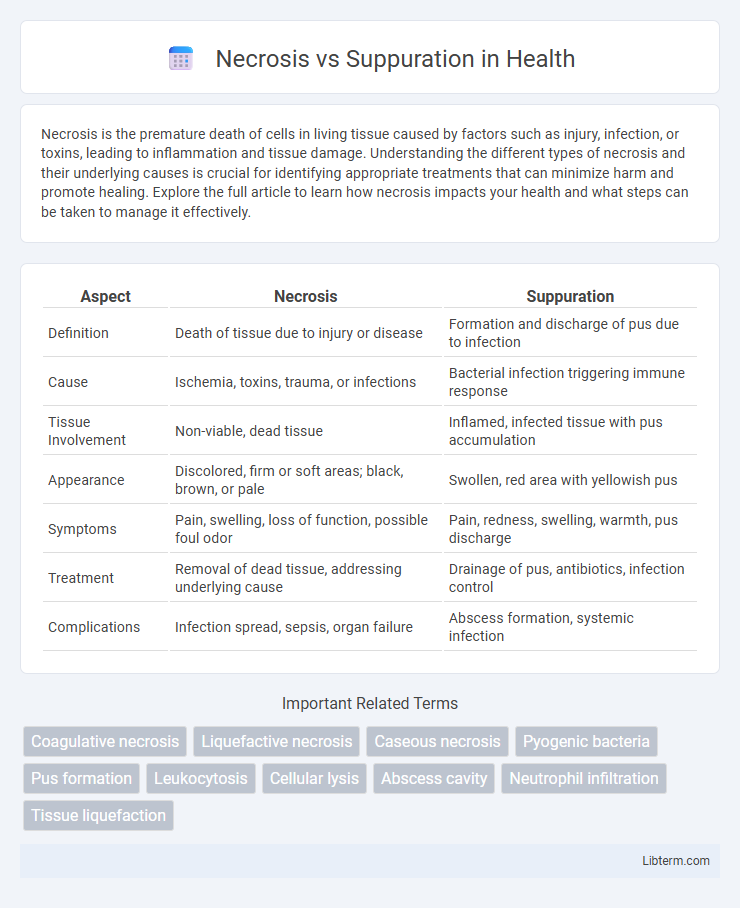Necrosis is the premature death of cells in living tissue caused by factors such as injury, infection, or toxins, leading to inflammation and tissue damage. Understanding the different types of necrosis and their underlying causes is crucial for identifying appropriate treatments that can minimize harm and promote healing. Explore the full article to learn how necrosis impacts your health and what steps can be taken to manage it effectively.
Table of Comparison
| Aspect | Necrosis | Suppuration |
|---|---|---|
| Definition | Death of tissue due to injury or disease | Formation and discharge of pus due to infection |
| Cause | Ischemia, toxins, trauma, or infections | Bacterial infection triggering immune response |
| Tissue Involvement | Non-viable, dead tissue | Inflamed, infected tissue with pus accumulation |
| Appearance | Discolored, firm or soft areas; black, brown, or pale | Swollen, red area with yellowish pus |
| Symptoms | Pain, swelling, loss of function, possible foul odor | Pain, redness, swelling, warmth, pus discharge |
| Treatment | Removal of dead tissue, addressing underlying cause | Drainage of pus, antibiotics, infection control |
| Complications | Infection spread, sepsis, organ failure | Abscess formation, systemic infection |
Introduction to Necrosis and Suppuration
Necrosis is the localized death of tissue due to factors like infection, toxins, or trauma, resulting in cell breakdown and loss of tissue function. Suppuration involves the accumulation of pus, a thick fluid composed of dead leukocytes, bacteria, and tissue debris, as a response to infection and inflammation. Understanding the distinction between necrosis and suppuration is crucial for diagnosing and managing infectious and inflammatory conditions effectively.
Definition of Necrosis
Necrosis is the pathological death of cells or tissues due to factors such as infection, toxins, or trauma, leading to irreversible damage and loss of function. It is characterized by cellular swelling, membrane rupture, and the release of intracellular contents, causing local inflammation. In contrast, suppuration refers to the process of pus formation as a result of the immune response to infection, involving infiltrating neutrophils and dead cells.
Definition of Suppuration
Suppuration is the biological process of pus formation as a result of the body's inflammatory response to infection, characterized by the accumulation of dead leukocytes, bacteria, and tissue debris. Unlike necrosis, which refers to the premature death of cells and tissues due to injury or disease, suppuration specifically involves the generation of purulent exudate within an abscess or infected wound. This process signals the body's active immune defense aimed at isolating and clearing bacterial infections.
Pathophysiological Differences
Necrosis involves the irreversible death of cells caused by factors like ischemia, toxins, or infection, leading to the breakdown of cellular structures and loss of tissue architecture. Suppuration, characterized by the accumulation of pus, arises from an acute inflammatory response where neutrophils infiltrate the site of infection, phagocytize pathogens, and release enzymes causing liquefactive necrosis. The pathophysiological distinction lies in necrosis representing cellular death without active immune engagement, whereas suppuration reflects a dynamic immune process aimed at containing and resolving infectious agents through pus formation.
Causes and Risk Factors
Necrosis occurs due to factors such as ischemia, toxins, and infections that lead to irreversible cell death, with risk factors including diabetes, severe trauma, and vascular diseases. Suppuration results from bacterial infections triggering pus formation, primarily caused by pyogenic bacteria like Staphylococcus aureus, with risk factors including compromised immunity, poor hygiene, and chronic wounds. Differentiating these conditions is essential for targeted treatment, as necrosis involves tissue death while suppuration involves localized infection and inflammation.
Clinical Manifestations
Necrosis presents clinically as localized tissue death with symptoms such as blackened, non-viable tissue, loss of sensation, and possible foul odor, often accompanied by swelling and pain if infection occurs. Suppuration is characterized by the accumulation of pus, leading to swollen, red, tender areas with fluctuance and systemic signs like fever and malaise due to infection. Both conditions may coexist, but necrosis primarily indicates tissue death, while suppuration signals active infection and inflammation.
Diagnostic Methods
Necrosis is identified through imaging techniques such as MRI and CT scans, revealing tissue death often accompanied by loss of contrast enhancement, while histopathological examination confirms cellular breakdown. Suppuration is diagnosed primarily by clinical evaluation of pus formation and confirmed with microbiological cultures to identify infectious agents. Laboratory tests including complete blood count and inflammatory markers further support the differentiation between necrosis and suppuration.
Treatment Approaches
Treatment approaches for necrosis primarily involve debridement to remove dead tissue and prevent infection, often followed by wound care and sometimes hyperbaric oxygen therapy to promote healing. In contrast, suppuration treatment centers on drainage of pus, antibiotic therapy to combat infection, and addressing the underlying cause of abscess formation. Both conditions may require surgical intervention, but necrosis demands more extensive tissue management, while suppuration emphasizes infection control and pus evacuation.
Prognosis and Complications
Necrosis indicates irreversible tissue death, often leading to loss of function and increased risk of secondary infections, which can complicate healing and worsen prognosis if not promptly managed. Suppuration involves the accumulation of pus due to infection, with potential complications including abscess formation, systemic sepsis, and delayed wound healing, affecting overall prognosis based on infection control and immune response. Early intervention and appropriate antimicrobial therapy are critical in both conditions to minimize complications and improve clinical outcomes.
Key Differences and Summary
Necrosis is the pathological death of cells or tissues due to injury or disease, characterized by loss of membrane integrity and enzyme breakdown, while suppuration involves the formation of pus as a result of infection and inflammation, mainly composed of dead neutrophils, bacteria, and tissue debris. Necrosis typically presents as a localized, irreversible process leading to tissue destruction, whereas suppuration represents an active immune response aimed at isolating and eliminating infectious agents. Key differences include necrosis's non-specific cell death mechanism versus suppuration's immune-mediated pus production, highlighting their distinct pathological roles and clinical implications.
Necrosis Infographic

 libterm.com
libterm.com